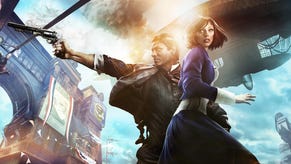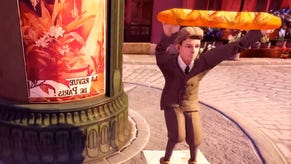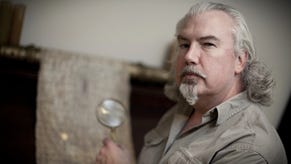Rebuilding Rapture
Behind the scenes on BioShock: Burial At Sea, and the impossible city's improbable return.
Andrew Ryan chose to build the impossible, but it was Ken Levine who decided to rebuild it. He chose Rapture. Again. A city where the artist would not fear the polygon count; where the programmer would not be bound by primitive Unreal shaders, Where great ambition would not be constrained by the limited expectations of DLC! With the sweat of Irrational's brow, Rapture is reborn as it was always meant to be - an objectivist utopia without equal, with a little film noir spice sprinkled on the top for good measure.
"Noir's always been an influence in BioShock, so we decided, f**k it, let's just go whole hog," Levine told me, mid-way through playing what's likely to be our penultimate trip to Rapture - the first episode of Burial At Sea, in which Booker's private detective agency gets relocated to the bottom of the Atlantic, a femme fatale version of Elizabeth discovers a new love of elegantly held cigarettes, and the connection between Rapture and Columbia is explored. "During Infinite, people asked if there'd be Rapture Easter Eggs, and that was a difficult question to answer. Not exactly, but that scene was a smack in the face that made you understand the whole universe."
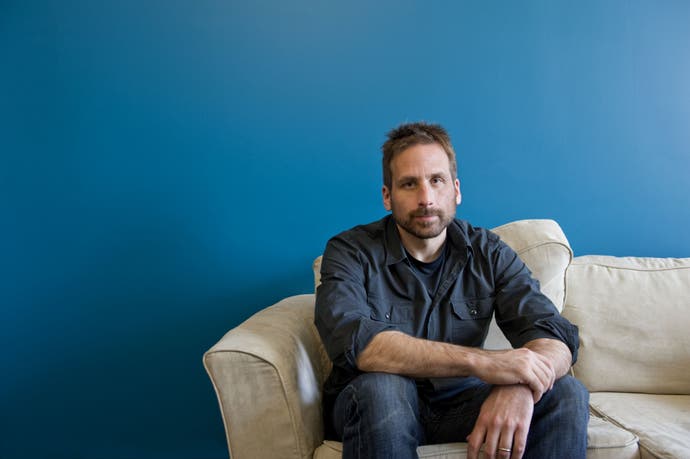
Returning to Rapture with Infinite level technology is a tempting proposition, though definitely a risky one. After all, one of BioShock 2's biggest struggles was convincing players who thought Rapture was done and dusted, especially with Infinite's announcement being exciting primarily for offering somewhere brand new to explore. For Levine though, the narrative potential makes taking one more trip worth the risk - its altered perspective making for a very different story, and a natural continuation of Infinite's unbroken circle. "I think BioShock is the story of Rapture, and Infinite the story of Elizabeth and Booker set against Columbia," he explains. "Here, it's them set against Rapture."
Why not something more.. well... expected though, like a run around Columbia with the Vox Populi, or picking up on some of the deleted content from the cutting room floor? If Rapture still has stories to tell after two games and the Minerva's Den DLC, surely Columbia has a few more left in it.
The clue of, course, is the word 'expected'.
"I always want to start these games with the audience slightly on the back foot, not sure what's happening," says Levine. "Did you watch The Sopranos? I'm rewatching it, and I just got to the bit where Tony gets shot and seems to be dying, but then in the next episode he's a businessman in LA. You go "Wait, what's happening?" and it turns out to be his fantasy while in a coma, of the life he might have had. I loved it because it threw me. Here, I wanted the same thing for the player - to put you in Rapture as Booker, and have Elizabeth come in and them not know each other."
Irrational's own experiences in the clouds also heavily shaped its return. "When building Columbia, we thought a lot about the hierarchy of the city - it was a pristine city, a functioning city, and we applied a lot of the answers to the questions we asked ourselves when making that to Burial At Sea," explained lead level designer Andres Gonzalez. "When we decided to do the DLC in Rapture, we knew we'd have to build it from the ground up in our new engine. What that allowed us was all this extra possibility, to take this power to create environments that are much grander in scale, with much more visual fidelity. One of the big things we bit off early on was that the ocean outside the windows didn't have to be a flat 2D texture - we could actually build it, and these vistas are now 3D."

"We had a lot of fun with the wildlife outside, like the whale outside the windows," adds animation director Shawn Robertson. "We were worried we wouldn't have time to fill that kind of stuff in, but we really wanted to. We actually had one of our riggers create this really crappy model of a sea turtle, just to shame the modellers into making us nicer ones. Everyone wanted to put their own stamp on returning to Rapture."
Perhaps the most surprising thing about Burial At Sea, particularly seeing its locations in the flesh, is that the brief glimpse of it in the original really wasn't intended as an appetite-whetting teaser. Far from it. "When we built the Rapture scene in Infinite, we hadn't even started talking about what we were going to do in the DLC," confirmed Gonzalez. "There were a lot of ideas thrown around, and when the idea of Rapture came up, the others fell away. We can build this, and the opportunities it offered for storytelling were worth it. We knew we wanted to bring back Booker and Elizabeth, and this gave us the chance to draw parallels from both worlds."
Making it happen hasn't been easy though, or cheap. While most DLC tends to be handled by a smaller team within a company, all hands are on deck - of a sunken ship, admittedly - on this one, not least because bridging the two worlds means digging deeper than a simple reskin. Rapture and Columbia have many similarities - constants, if you prefer - like the plasmids/vigors, but they're also very different experiences, with BioShock leaning towards horror and Infinite to the grandiose. This had to be factored in, with elements from both games combining in an attempt to bridge the two worlds without losing Rapture's original charm. Some of them though might raise an eyebrow, like the addition of skylines to Rapture's interiors, and Booker's fire attacks coming courtesy of a Devil's Kiss vigor rather than an Incinerate! plasmid. Is this just a case of post-Infinite expectations weighing in on the design?
"When we decided to do Rapture, we asked ourselves those questions," answers Gonzalez. "In the end, the decision was made because when we started drawing out what we wanted to put into this story from both worlds, we had to put in the things that we were excited about creativily, but also unique gameplay experiences drawing from both. When we looked at skylines, we decided that we didn't want to remove that tactical choice from the player's options. That's why we made the decision, not because we felt it was expected. We also reworked and rebalanced the systems to be more about resource management and stealth, which changed the way the encounters played to be more like the original BioShock. Because it's based on Infinite's engine though, you can hear encounters in the distance, and plan your attacks, which makes things like setting traps more useful than they were in Columbia."
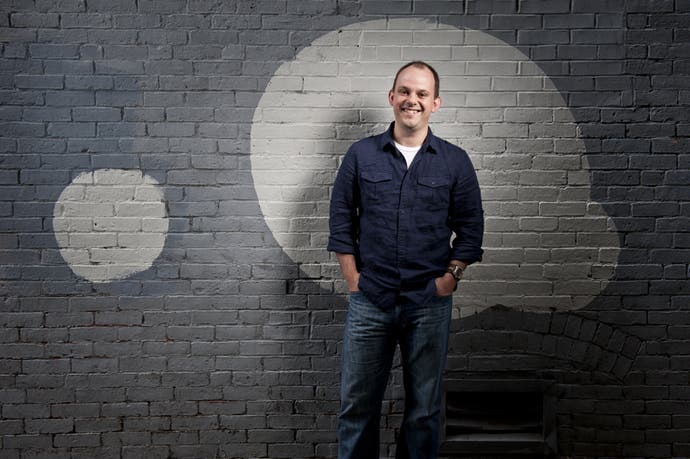
The horror element isn't really present in the bright lights of Rapture's civilised society, but that's just a small part of the DLC. It's not long before they give way to the more traditional darkness and creepy brutalities of Burial At Sea's combat location, a sunken department store turned prison for splicers who made the political mistake of supporting Atlas/Fontaine, and are now busy getting a head-start on the craziness about to engulf the city.
"Building a scary space is all about tension, and playing with anticipation," continues Gonzalez. "We designed the encounters in a way that there's a degree of unpredictability to them - the hope is that players always feel a little on edge, like an attack could come from anywhere or be set off at any time, because resource management is more important. It takes craft to paste things out so that things have the necessary ups and downs. We had to rethink how Booker and Elizabeth reacted, and how the AIs reacted to them. She can point enemies out and warn you, and reacts to them, and we tuned the resources she gives you to scarcity so that now when she gives you something it feels awesome. It's all about setting those levers just right so that they don't interfere with each other. A more aggressive player might not feel it, but one who's sneaking around will, and maybe change their tactics."
The presence of Elizabeth also provided a way to further differentiate this visit from Rapture from others - her new darker look not simply a film noir homage, but intended to represent her current state of mind, and act as a new lens with which to see the city. She's unfamiliar with many of its elements (Booker having to explain details like the Little Sisters as Rapture valuing children, not childhood) but distinctly less shocked by its horrors than the Elizabeth of old. Her newfound cynicism isn't just a reminder of the truth underneath the luxury though, but the next step in her transition from sheltered innocent to her own woman - one who still has her dimension-ripping powers.
"We're able to show the effect of ideas," continues Levine, returning to the story side. "Marxism was just an idea - Karl Marx and Engels were just two guys in a coffee shop, writing a bunch of stuff. Cut to 1935, and Stalin is making collectivist farms and tens of millions of people are dying of starvation because of those two guys writing ideas down. That could be you! It could be me! We showed the city impact of that in Rapture, and I felt we'd done that, and now wanted to focus on the human impact. It's the global turned to the personal - what ideology does to a person... how it can change them, poison them." As a specific example? "There's a dancing scene in Infinite, where she's on the beach, carefree. Then there's a new dancing scene in Burial At Sea, which is as distant from that as it's possible to be. The delta between the two Elizabeths is so huge because of Columbia - what her father created."

Noir fans will notice though that while Elizabeth is taking pages from the genre's textbook, it's only really in the opening that she follows it to the letter - her style as much about conveying her continued evolution as her creators' love of her borrowed genre. "We had a bunch of touch points, like Chinatown and Double Indemnity, but I think it's one of those universal tropes," said Robertson. "As soon as you see her, you just know what her character is."
Both he and Irrational wanted to avoid her simply being a genre pastiche though, and definitely not a parody - though not to the point that her walk doesn't involve rather more swing than before, or in any way that prevented both Dead Men Don't Wear Plaid and Who Framed Roger Rabbit going on the research pile. "That's the film that really pushed me into wanting to go into animation!" Robertson added. "It's a comedy and obviously a cartoon, but it's still a classic noir film. But I digress! I think not slipping over into comedy is something you just need to have to let your taste guide you on. It's funny though, because when you put makeup and eye-liner on her and change her clothes, Elizabeth feels like a different person even though the underlying geometry hasn't changed."
As important as she is to the story though, and as prominent during the action, everyone knows that BioShock's true star was called Rapture - and that's the case here too. It would have been easy to underwhelm here, and fall short of the mental images that the ruins of the original game created. Instead, every part of the process from modelling to texture to musical choices goes hand in hand to turn a world that was already one of a kind into something admittedly smaller, but every bit as impressively realised as its politically incorrect sister city high up in the clouds.
If this is the final send-off for both cities, it's a fantastically ambitious one - especially considering that it's DLC rather than a whole new game. Even so, and while absolutely nothing has been announced, we definitely shouldn't rule out a similar return to Columbia at some point - not least because nostalgic trips to old stomping grounds have been a bit of an Irrational tradition since System Shock 2. We just need a new man, a new lighthouse and a new city - or simply for Ken Levine to think of a good reason. Given the opportunity, it's unlikely the multiverse won't provide.




